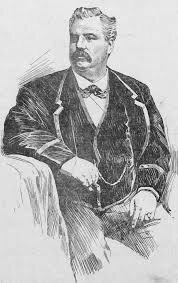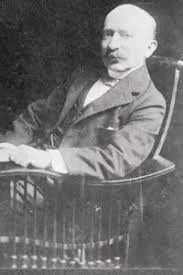Howe & Hummel: The Crookedest and Most Successful Lawyers of the Gilded Age
If you've read my novel Courting Anna, with its female lawyer protagonist, you'll suspect that I have a special interest in lawyers in history. Whether it's 19th century women lawyers in America, like Belva Lockwood and Clara Shortridge Foltz, or the fictional lawyers who inhabit Victorian novels, like Dickens's Jaggers and Anthony Trollope's Mr. Chaffanbrass, I love to read about them. One of the most fascinating pairs in 19th century legal history, though, is the notorious Howe & Hummel, who dominated a certain part of the legal landscape in Gilded Age New York -- the most crooked and the most sensational.
The partners were, in many ways, opposites. William Howe, born in England but always a bit elusive about his past, was extremely tall and stout, and flashy, loving to wear diamonds. Theatrical in the courtroom, he specialized in criminal cases, and was on retainer for many of the most notorious crooks of his time. Abraham Hummel, on the other hand, was barely five feet tall, and much less dramatic in his self-presentation, but equally effective. Specializing in civil cases, he also maintained a sideline in blackmail. He began as a clerk in Howe's mailroom but within six years, and with apparently no formal legal education, he had risen to full partnership.
William Howe
Howe and Hummel believed in bluster -- and weren't terribly concerned with the truth. Their clients ranged from famous fence "Marm" Mandelbaum, through whose warehouse many of the stolen goods in New York passed, notorious burglars like John "Red" Leary, and many of the leaders and followers involved in the Whyos and other "gangs of New York" of the day. Pickpockets and corrupt Tammany politicians could be found side by side in their dingy waiting room located conveniently across the street from the criminal courts building.
But their clients weren't limited to the criminal classes by any means. Wealthy men fearing blackmail over their extracurricular activities would hire them too -- assuming the blackmailers hadn't retained them first. Evelyn Nesbit, the chorus girl over whom millionaire Harry K. Thaw shot celebrated architect Stanford White, was a client. So were other figures of the stage of the day, like actresses Lily Langtry and Lillian Russell and actor Sir Henry Irving, as well as the dancer known as "Little Egypt," who introduced the "hoochee coochee" to the American stage. Mark Twain hired Hummel, as well -- as did respected organizations like the Actors' Fund and the French Society of Dramatists. As for Howe, in a case perhaps of knowing your enemy, he was invited onto the team that revised the state penal code in 1882.
Abraham Hummel
When Howe died in 1902 he was eulogized as the "dean of the criminal bar," Hummel fell victim to the rising tides of reform. William Travers Jerome, a cousin of Winston Churchill's on his mother's side, was determined to bring Hummel down, and in July 1906 he was suspended from the practice of law and permanently disbarred. The following year he was convicted of conspiracy to defraud the courts and was imprisoned in the notorious Blackwell's Island. Released in 1908, he set sail for England, where he lived in luxury on Grosvenor Square, until his death in 1926.
For Howe and Hummel, crime certainly paid. You can read more about them in Richard Rovere's Howe & Hummel: Their Scandalous History and Cait Murphy's Scoundrels in Law. I myself am looking forward to reading The Confessions of Artemas Quibble, a satirical roman-a-clef about the pair written by Arthur Train, who as district attorney faced off against both of them.
This post originally eppeared in the Prairie Rose Publications blog on 10/20/2020

